The balance of evidence suggests a discernable human influence on global climate.
Intergovernmental Panel of Climate Change (IPCC), Second Assessment Report, 1995.
There is new and stronger evidence that most of the warming observed over the last 50 years is attributable to human activities.
IPCC, Third Assessment Report, 2001.
Human-induced warming of the climate system is widespread.
IPCC, Fourth Assessment Report, 2007.
The climate is an angry beast, and we’re poking it with sticks
Wallace Broecker
“Four times more carbon is contained in permafrost,” Max said this morning, “than in the entire biomass in the rest of the world.”
Wait, did I hear that right? The entire rest of the world’s biomass? Four times?
“That’s right.”
He then posed this rhetorical question: “What can be done in the Arctic about climate change?” And answered it: “Nothing.”
The Arctic, where only a tiny fraction of the world’s population lives, produces almost no greenhouse gasses. The forces changing world climate originate south of the Arctic Circle, where most of us live; yet they are inevitably transported to the Arctic aboard the winds and ocean currents. This unique region is uniquely vulnerable to climate change. Arctic scientists, no matter their individual disciplines, are well aware that the climate in the Arctic has already changed. And those of us who are not scientists but who have fallen in love with the Arctic seas, the light, and the landscape want to shout hard words and profane admonitions. Do not ruin this magnificent place! But that’s futile and a bit silly—at whom do we shout?—so with some effort I’ll suspend anger and sadness for a few hundred words and try to speak in measured scientific language.
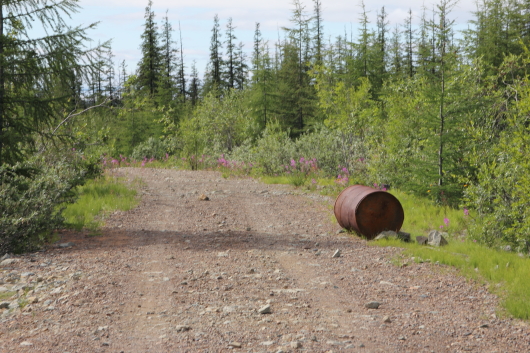
An abandoned barrel sits on the side of a road we walk along to get from Orbita to Y4, Shuchi Lake and a number of terrestrial survey sites. © Becky Tachihara
It all comes down to carbon and, as Max has been thinking, time. The carbon cycle works on short, long, and very long timescales. On a daily basis, there is that balance between photosynthesis and respiration. To simplify, green plants and trees exploit solar energy to photosynthesize. Doing so, they take in carbon dioxide and release oxygen as a byproduct. At night the opposite process occurs, but to a lessor extent. The same balance occurs on seasonal scales if we think of summer as a long day, and vice versa. Therefore, forests are net carbon sinks, which is why it’s a good idea not to chop them down. Then when plants and trees die, their carbon is eaten by microorganisms, which respire carbon dioxide into the atmosphere. (As breathers, we do the same thing.) But that carbon dioxide then gets transferred out of the atmosphere back to the plants through photosynthesis. That generally balanced process has been going down since living plants first appeared on Earth.
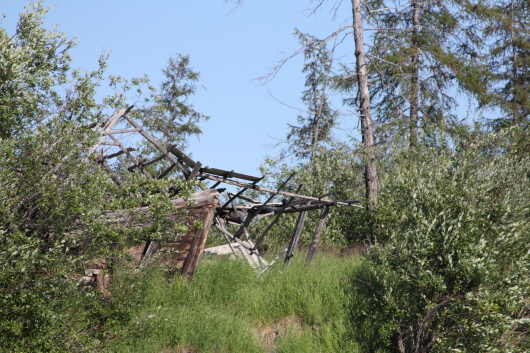
An abandoned shack decomposes on the riverbank. According to Nikita, this shack was once part of the Northeast Science Station. © Becky Tachihara
Some 359 million years ago at the dawn of the Carboniferous period an unprecedented profusion of ferns and leafy trees sprang to life in an atmosphere extra rich in carbon dioxide; that’s why it’s called the Carboniferous. About 250 million years’-worth of plants lived and died, and then, as now, microorganisms ate at their remains and respired carbon dioxide. (In technical language, carbon delectable to microorganisms is said to be labile.) However, the microorganisms were unable to consume and decompose all that plant material, labile though it was.
The Carboniferous environment was generally wet, swampy, fetid, and humid; we might visualize the cypress swamps in Louisiana bayou country spread globally. Thus, when the trees and plants died, they fell into swampy water, which is low in oxygen and highly acidic, undesirable conditions for the propagation of microorganisms. In other words, photosynthesis (or “primary production”) exceeded respiration. When that happens, carbon matter accumulates, and when it happens over millions of years, a lot of carbon accumulates. Never has it accumulated in such quantities as during the Carboniferous period. Many more millions of years passed after the close of the Carboniferous, and this carbon was buried by sediment, which eventually was compressed into rock wherein thick reservoirs of carbon remained locked.
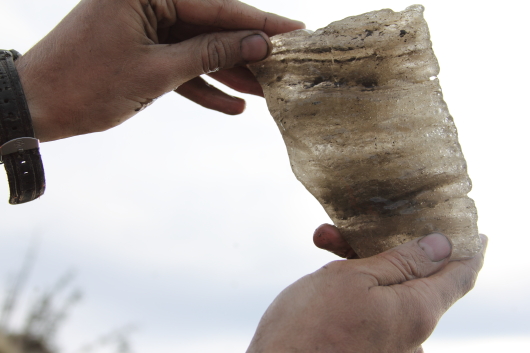
Sam holds up a piece of a Duvannyi Yar ice wedge to the light to look at layers formed over the course of thousands of years. © Becky Tachihara
Sooner or later some other world-changing geologic activity—volcanoes, say, or a tectonic uplift—would occur to awaken the cycle by exposing the sleeping carbon to the air where ensuing generations of microorganisms could chomp on it respiring fresh carbon dioxide into the atmosphere. However, we discovered the carbon deposits before dynamic geology exposed them—but after other geologic processes had transformed the carbon into what we now call fossil fuel.
We learned that by burning this very, very old carbon we could do things humans had never done before. It was a wonderful discovery, downright Promethean. We could heat our homes in winter, cool them in summer, light them at night; we could power modes of transportation capable of moving people and large products over great distances very rapidly. We acquired unprecedented mobility. By burning ancient carbon, we could power a vast range of smaller devices for our personal pleasure, development, and edification including the computers on which you’re reading these words and the music I’m listening to as I write them. We love to burn carbon; we do so now to the tune of eight billion tons each year. But then relatively recently we discovered the darker side to our love affair. We learned that it was altering our climate. We didn’t mean to. Who would have imagined we owned geophysical-scale power? Now we know that we do. Only energy-industry shills, corporate errand boys, and willful ideologues deny it.
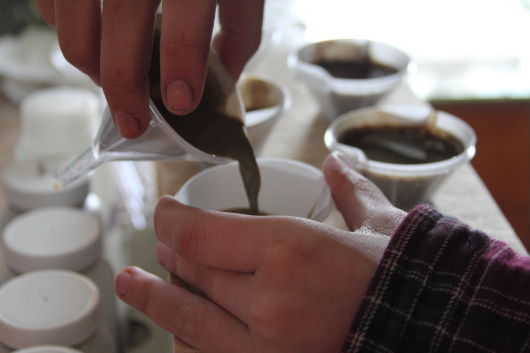
Ludda pours a solution of soil and water into a clean filter. The samples need to run clear after filtering so the analysis will be accurate, so she is meticulous. © Becky Tachihara
But the more thoughtful and honest among us may still be unaware of this other stock of younger, call it intermediate-timescale carbon frozen some twenty to fifty thousand years ago beneath the Siberian landscape—four times greater in mass than all the rest of the biomass carbon on Earth. Burning Carboniferous-period carbon is causing deleterious effects in atmosphere, but at least we’ve gained measurable value and quality-of-life improvement by doing so. Also, we have a degree of choice in what we do or don’t do in the future. If we can muster the individual and somehow the political will, if we apply the same sort of intellectual facilities and technical capabilities that have brought us to this remove, turning the Holocene, our present geologic period spanning the last 10,000 years, into the “Anthropocene,” then we might mitigate the self-destructive side of physical human advancement. Maybe not. But at least we can’t say we have no choice. However, nothing good will result if we release the permafrost genie from the frozen ground. We can’t make use of that carbon; we can’t burn it. Its exposure to the air will only hurt us, and we’ll have no choice except to endure the upshot.
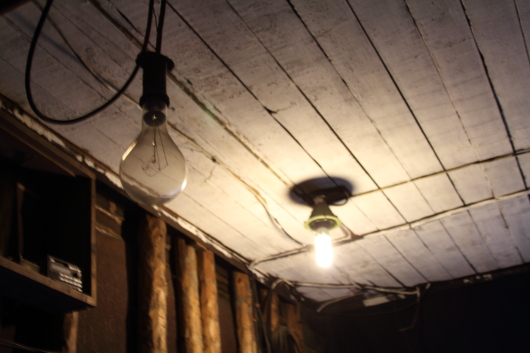
Lightbulbs hang from the ceiling in the permafrost cave below the soil lab. The cave is kept at 10 degrees Celsius and is used for cold storage of samples, moose meat , some tools and assorted beverages. © Becky Tachihara
As I watch these diligent scientists and students try to glean the state of permafrost carbon, I think about the Arctic and our relationship to it in something like literary terms, specifically the role of retribution in tragic drama. (Macbeth murders the king, loosing chaos on the land. Resolution requires retribution; Macbeth must die.) Here we are, inflicting our anthropogenic warming on the delicate Arctic. The Arctic is helpless in the face of it. But if we hurt it badly enough, if we push it far enough beyond some yet-unknown tipping point to actually thaw the permafrost, then the retributive result may well be akin to climate chaos. Maybe that’s to strain the science as well as the metaphor. I don’t know, maybe after these carbon scientists finish collecting their water and soil samples and their subsequent lab analysis of them, they’ll find some good news for the Arctic. Maybe it’s not too late. Maybe we still have time time to stave off the retributive chaos.
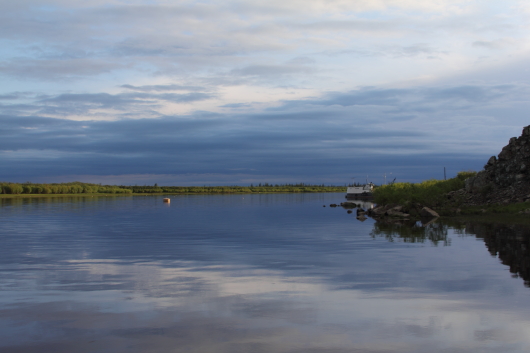
Smooth as glass, the Panteleikha reflects the cloudy evening sky – a stunning example of the sheer beauty of this place we have the opportunity to study. © Becky Tachihara



